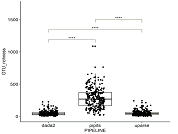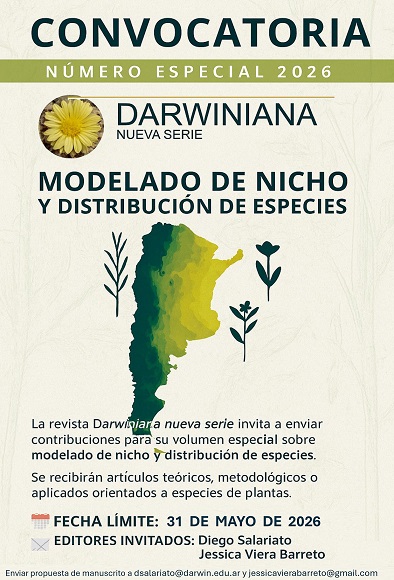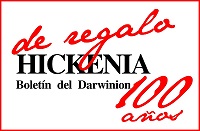Evaluación de la diversidad de endófitos fúngicos: un estudio comparativo de tres flujos de trabajo automatizados de metabarcoding
DOI:
https://doi.org/10.14522/darwiniana.2023.112.1127Palabras clave:
ADN ambiental, AMPtk, bosques de Nothofagus, endófitos fúngicos, PIPITSResumen
La utilización de la secuenciación de alto rendimiento se ha vuelto frecuente en el estudio de comunidades endófitas. Estas tecnologías han permitido la descripción acumulativa de diversidad fúngica a lo largo de la última década. No obstante, también han implicado nuevos desafíos para los investigadores de las áreas involucradas en términos de la necesidad de contar con herramientas de programación y habilidades desarrolladoras. Hoy en día no existe un consenso sobre las herramientas bioinformáticas más adecuadas para procesar los datos crudos de secuencias que estas tecnologías arrojan. El objetivo de este trabajo fue comparar el rendimiento de tres flujos de trabajo realizados en dos plataformas gratuitas diseñadas para ser amigables con usuarios que no son programadores y desarrolladas específicamente para estudios de hongos: AMPtk y PIPITS. Evaluamos los ensambles de hongos que habitan en la albura de dos especies de Nothofagus de los bosques patagónicos y comparamos el conjunto de datos de metabarcoding del espaciador transcrito interno (ITS) con un conjunto de datos de secuencias existente, obtenido de la prospección de cultivos de los mismos árboles y sitios de estudio. La plataforma AMPtk se desempeñó mejor con respecto a la descripción de la comunidad, en términos de precisión del agrupamiento de taxones, principalmente debido al algoritmo DADA2. El flujo de trabajo PIPITS evidenció una mayor sensibilidad en la detección de taxones conocidos presentes, por lo que es potencialmente útil para futuros estudios que persigan la detección de taxones específicos. Debido a la falta de información que exhiben las bases de datos de referencia sobre el ecosistema en estudio, ambas plataformas tuvieron un desempeño deficiente en cuanto a la asignación de taxonomías. Es imperativo seguir estudiando estos ecosistemas y mejorar las bases de datos para aumentar el potencial explicativo de las nuevas tecnologías.
Citas
Aird, D.; M. G. Ross, W.-S. Chen, M. Danielsson, T. Fennell, C. Russ, D. B. Jaffe, C. Nusbaum & A. Gnirke. 2011. Analyzing and Minimizing PCR Amplification Bias in Illumina Sequencing Libraries. Genome Biology 12 (2): R18. DOI: https://doi.org/10.1186/gb-2011-12-2-r18
Altschul, S.; T. L. Madden, A. A. Schäffer, J. Zhang, Z. Zhang, W. Miller & D. J. Lipman. 1997. Gapped BLAST and PSI-BLAST: A New Generation of Protein Database Search Programs. Nucleic Acids Research 25 (17): 3389-3402. DOI: https://doi.org/10.1093/nar/25.17.3389
Anslan, S.; R. H. Nilsson, C. Wurzbacher, P. Baldrian, L. Tedersoo & M. Bahram. 2018. Great Differences in Performance and Outcome of High-Throughput Sequencing Data Analysis Platforms for Fungal Metabarcoding. MycoKeys 39: 29-40. DOI: https://doi.org/10.3897/mycokeys.39.28109
Baldrian, P. 2016. Forest Microbiome: Diversity, Complexity and Dynamics. FEMS Microbiology Reviews 41 (2): 109-30. DOI: https://doi.org/10.1093/femsre/fuw040
Baldrian, P.; T. Větrovský, C. Lepinay & P. Kohout. 2021. High-Throughput Sequencing View on the Magnitude of Global Fungal Diversity. Fungal Diversity 114: 539-547. DOI: https://doi.org/10.1007/s13225-021-00472-y
Bengtsson-Palme, J.; M. Ryberg, M. Hartmann, S. Branco, Z. Wang, A. Godhe, P. De Wit et al. 2013. Improved Software Detection and Extraction of ITS1 and ITS2 from Ribosomal ITS Sequences of Fungi and Other Eukaryotes for Analysis of Environmental Sequencing Data. Methods in Ecology and Evolution 4 (10): 914-919. DOI: https://doi.org/10.1111/2041-210X.12073
Brown, S. P.; A. M. Veach, A. R. Rigdon-Huss, K. Grond, S. K. Lickteig, K. Lothamer, A. K. Oliver & A. Jumpponen. 2015. Scraping the Bottom of the Barrel: Are Rare High Throughput Sequences Artifacts? Fungal Ecology 13: 221-225. DOI: https://doi.org/10.1016/j.funeco.2014.08.006
Callahan, B. J.; P. J. McMurdie, M. J. Rosen, A. W. Han, A. J. A. Johnson & S. P. Holmes. 2016. DADA2: High-Resolution Sample Inference from Illumina Amplicon Data. Nature Methods 13 (7): 581-83. DOI: https://doi.org/10.1038/nmeth.3869
Callahan, B. J.; P. J. McMurdie & S. P Holmes. 2017. Exact Sequence Variants Should Replace Operational Taxonomic Units in Marker-Gene Data Analysis. The ISME Journal 11 (12): 2639-2643. DOI: https://doi.org/10.1038/ismej.2017.119
Costello, M. J.; R. M. May & N. E. Stork. 2013. Can We Name Earth’s Species Before They Go Extinct? Science 339 (6118): 413-416. DOI: https://doi.org/10.1126/science.1230318
Dumolin, S.; B. Demesure & R. J. Petit. 1995. Inheritance of Chloroplast and Mitochondrial Genomes in Pedunculate Oak Investigated with an Efficient PCR Method. Theoretical and Applied Genetics 91 (8): 1253-1256. DOI: https://doi.org/10.1007/BF00220937
Edgar, R. C. 2010. Search and Clustering Orders of Magnitude Faster than BLAST. Bioinformatics 26 (19): 2460-2461. DOI: https://doi.org/10.1093/bioinformatics/btq461
Edgar, R. C. 2013. UPARSE: Highly Accurate OTU Sequences from Microbial Amplicon Reads. Nature Methods 10 (10): 996-998. DOI: https://doi.org/10.1038/nmeth.2604
Edgar, R. C. 2016. SINTAX: A Simple Non-Bayesian Taxonomy Classifier for 16S and ITS Sequences. BioRxiv, 074161. DOI: https://doi.org/https://doi.org/10.1101/074161
Edgar, R. C. & H. Flyvbjerg. 2015. Error Filtering, Pair Assembly and Error Correction for next-Generation Sequencing Reads. Bioinformatics 31 (21): 3476-3482. DOI: https://doi.org/10.1093/bioinformatics/btv401
Frøslev, T. G.; R. Kjøller, H. H. Bruun, R. Ejrnæs, A. K. Brunbjerg, C. Pietroni & A. J. Hansen. 2017. Algorithm for Post-Clustering Curation of DNA Amplicon Data Yields Reliable Biodiversity Estimates. Nature Communications 8 (1): 1188. DOI: https://doi.org/10.1038/s41467-017-01312-x
Gardes, M. & T. D. Bruns. 1993. ITS Primers with Enhanced Specificity for Basidiomycetes - Application to the Identification of Mycorrhizae and Rusts. Molecular Ecology 2 (2): 113-118. DOI: https://doi.org/10.1111/j.1365-294X.1993.tb00005.x
Gdanetz, K.; G. M. N. Benucci, N. Vande Pol & G. Bonito. 2017. CONSTAX: A Tool for Improved Taxonomic Resolution of Environmental Fungal ITS Sequences. BMC Bioinformatics 18 (1): 538. DOI: https://doi.org/10.1186/s12859-017-1952-x
Gordon, A. & G. J. Hannon. 2010. Fastx-Toolkit. FASTQ/A Short-Reads Preprocessing Tools (Unpublished) Http://Hannonlab. Cshl. Edu/Fastx_toolkit.
Gweon, H. S.; A. Oliver, J. Taylor, T. Booth, M. Gibbs, D. S. Read, R. I. Griffiths & K. Schonrogge. 2015. PIPITS: An Automated Pipeline for Analyses of Fungal Internal Transcribed Spacer Sequences from the Llumina Sequencing Platform. Methods in Ecology and Evolution 6 (8): 973-980. DOI: https://doi.org/10.1111/2041-210X.12399
Halwachs, B.; N. Madhusudhan, R. Krause, R. H. Nilsson, C. Moissl-Eichinger, C. Högenauer, G. G. Thallinger & G. Gorkiewicz. 2017. Critical Issues in Mycobiota Analysis. Frontiers in Microbiology 8: 1-12. DOI: https://doi.org/10.3389/fmicb.2017.00180
Heine, P.; J. Hausen, R. Ottermanns & M. Roß-Nickoll. 2021. Comparing EDNA Metabarcoding with Morphological Analyses: Fungal Species Richness and Community Composition of Differently Managed Stages along a Forest Conversion of Norway Spruce towards European Beech in Germany. Forest Ecology and Management 496: 119429. DOI: https://doi.org/10.1016/j.foreco.2021.119429
Jalili, V.; E. Afgan, Q. Gu, D. Clements, D. Blankenberg, J. Goecks, J. Taylor & A. Nekrutenko. 2020. The Galaxy Platform for Accessible, Reproducible and Collaborative Biomedical Analyses: 2020 Update. Nucleic Acids Research 48 (W1): W395-402. DOI: https://doi.org/10.1093/nar/gkaa434
James, T. Y.; J. E. Stajich, C. T. Hittinger & A. Rokas. 2020. Toward a Fully Resolved Fungal Tree of Life. Annual Review of Microbiology 74 (1): 291-313. DOI: https://doi.org/10.1146/annurev-micro-022020-051835
Kirker, G. T.; A. B. Bishell, M. A. Jusino, J. M. Palmer, W. J. Hickey & D. L. Lindner. 2017. Amplicon-Based Sequencing of Soil Fungi from Wood Preservative Test Sites. Frontiers in Microbiology 8: 1997. DOI: https://doi.org/10.3389/fmicb.2017.01997
Küngas, K.; M. Bahram & K. Põldmaa. 2020. Host Tree Organ Is the Primary Driver of Endophytic Fungal Community Structure in a Hemiboreal Forest. FEMS Microbiology Ecology 96 (2): 1-10. DOI: https://doi.org/10.1093/femsec/fiz199
McMurdie, P. J. & S. Holmes. 2013. Phyloseq: An R Package for Reproducible Interactive Analysis and Graphics of Microbiome Census Data. Edited by Michael Watson. PLoS ONE 8 (4): e61217. DOI: https://doi.org/10.1371/journal.pone.0061217
McMurdie, P. J. & J. N. Paulson. 2016. Biomformat: An Interface Package for the BIOM File Format. R/Bioconductor Package.
Migliorini, D.; M. Messal, A. Santini, A. P. Ramos, P. Talhinhas, M. J. Wingfield & T. Burgess. 2021. Metabarcoding Reveals Southern Hemisphere Fungal Endophytes within Wood of Cultivated Proteaceae in Portugal. European Journal of Plant Pathology 160 (1): 173-184. DOI: https://doi.org/10.1007/s10658-021-02233-8
Molina, L.; M. Rajchenberg, A. de Errasti, M. C. Aime & M. B. Pildain. 2020. Sapwood-Inhabiting Mycobiota and Nothofagus Tree Mortality in Patagonia: Diversity Patterns According to Tree Species, Plant Compartment and Health Condition. Forest Ecology and Management 462: 117997. DOI: https://doi.org/10.1016/j.foreco.2020.117997
Molina, L.; M. Rajchenberg, A. de Errasti, B. Vogel, M. P. A. Coetzee, M. C. Aime & M. B. Pildain. 2022. Sapwood mycobiome varies across host, plant compartment and environments in Nothofagus forests from Northern Patagonia. Molecular Ecology 00: 1-20. DOI: https://doi.org/10.1111/mec.16771
Molina, L. & M. B. Pildain. 2022. Uso de la secuenciación de segunda generación (NGS) para descubrir la diversidad de hongos degradadores de la madera en los bosques Andino Patagónicos. Lilloa 59 (Suplemento): 155-172. DOI: https://doi.org/10.30550/j.lil/2022.59.S/2022.09.22
Mysara, M.; M. Njima, N. Leys, J. Raes & P. Monsieurs. 2017. From Reads to Operational Taxonomic Units: An Ensemble Processing Pipeline for MiSeq Amplicon Sequencing Data. GigaScience 6 (2): 1-10. DOI: https://doi.org/10.1093/gigascience/giw017
Nilsson, R. H.; S. Anslan, M. Bahram, C. Wurzbacher, P. Baldrian & L. Tedersoo. 2019. Mycobiome Diversity: High-Throughput Sequencing and Identification of Fungi. Nature Reviews Microbiology 17 (2): 95-109. DOI: https://doi.org/10.1038/s41579-018-0116-y
Oksanen, J.; F. G. Blanchet, M. Friendly, R. Kindt, P. Legendre, D. McGlinn, P. R. Minchin, R. B. O’Hara, G. L. Simpson & P. Solymos. 2020. Vegan: Community Ecology Package. R Package Version 2.5.7. 2020.
Palmer, J. M.; M. A. Jusino, M. T. Banik & D. L. Lindner. 2018. Non-Biological Synthetic Spike-in Controls and the AMPtk Software Pipeline Improve Mycobiome Data. PeerJ 6 (5): e4925. DOI: https://doi.org/10.7717/peerj.4925
Pauvert, C.; M. Buée, V. Laval, V. Edel-Hermann, L. Fauchery, A. Gautier, I. Lesur, J. Vallance & C. Vacher. 2019. Bioinformatics Matters: The Accuracy of Plant and Soil Fungal Community Data Is Highly Dependent on the Metabarcoding Pipeline. Fungal Ecology 41: 23-33. DOI: https://doi.org/10.1016/j.funeco.2019.03.005
Porter, T. M.; J. E. Skillman & J.-M. Moncalvo. 2008. Fruiting Body and Soil RDNA Sampling Detects Complementary Assemblage of Agaricomycotina (Basidiomycota, Fungi) in a Hemlock-Dominated Forest Plot in Southern Ontario. Molecular Ecology 17 (13): 3037-3050. DOI: https://doi.org/10.1111/j.1365-294X.2008.03813.x
Purahong, W.; A. Mapook, Y.-T. Wu & C.-T. Chen. 2019. Characterization of the Castanopsis carlesii Deadwood Mycobiome by Pacbio Sequencing of the Full-Length Fungal Nuclear Ribosomal Internal Transcribed Spacer (ITS). Frontiers in Microbiology 10: 1-14. DOI: https://doi.org/10.3389/fmicb.2019.00983
R Core Team. 2022. R: A language and environment for statistical computing. R Foundation for Statistical Computing, Vienna, Austria. Available at https://www.R-project.org/
Rognes, T.; T. Flouri, B. Nichols, C. Quince & F. Mahé. 2016. VSEARCH: A Versatile Open Source Tool for Metagenomics. PeerJ 4 (10): e2584. DOI: https://doi.org/10.7717/peerj.2584
Roper, M.; C. Ellison, J. W. Taylor & N. L. Glass. 2011. Nuclear and Genome Dynamics in Multinucleate Ascomycete Fungi. Current Biology 21 (18): R786-93. DOI: https://doi.org/10.1016/j.cub.2011.06.042
Saikkonen, K.; S. H. Faeth, M. Helander & T. J. Sullivan. 1998. Fungal Endophytes: A Continuum of Interactions with Host Plants. Annual Review of Ecology and Systematics 29 (1): 319-343. DOI: https://doi.org/10.1146/annurev.ecolsys.29.1.319
Schloss, P. D. & S. L. Westcott. 2011. Assessing and Improving Methods Used in Operational Taxonomic Unit-Based Approaches for 16S RRNA Gene Sequence Analysis. Applied and Environmental Microbiology 77 (10): 3219-3226. DOI: https://doi.org/10.1128/AEM.02810-10
Schoch, C. L.; K. A. Seifert, S. Huhndorf, V. Robert, J. L. Spouge, C. A. Levesque, W. Chen et al. 2012. Nuclear Ribosomal Internal Transcribed Spacer (ITS) Region as a Universal DNA Barcode Marker for Fungi. Proceedings of the National Academy of Sciences of the United States of America 109 (16): 6241-6246. DOI: https://doi.org/10.1073/pnas.1117018109
Schoch, C. L, B. Robbertse, V. Robert, D. Vu, G. Cardinali, L. Irinyi, W. Meyer et al. 2014. Finding Needles in Haystacks: Linking Scientific Names, Reference Specimens and Molecular Data for Fungi. Database 2014: bau061-bau061. DOI: https://doi.org/10.1093/database/bau061
Smith, D. P. & K. G. Peay. 2014. Sequence Depth, Not PCR Replication, Improves Ecological Inference from Next Generation DNA Sequencing. PLoS ONE 9 (2): e90234. DOI: https://doi.org/10.1371/journal.pone.0090234
Stone, J. K.; J. D. Polishook & J. F. J. White. 2004. Endophytic Fungi. In Biodiversity of Fungi: Inventory and Monitoring Methods, edited by G. M. Mueller; G. F. Billis & M. S. Foster, 241-270. Burlinghton: Elsevier. DOI: https://doi.org/10.13140/RG.2.1.2497.0726
Suryanarayanan, T. S. 2020. The Need to Study the Holobiome for Gainful Uses of Endophytes. Fungal Biology Reviews 34 (3): 144-150. DOI: https://doi.org/10.1016/j.fbr.2020.07.004
Tedersoo, L.; S. Anslan, M. Bahram, S. Põlme, T. Riit, I. Liiv, U. Kõljalg et al. 2015. Shotgun Metagenomes and Multiple Primer Pair-Barcode Combinations of Amplicons Reveal Biases in Metabarcoding Analyses of Fungi. MycoKeys 10: 1-43. DOI: https://doi.org/10.3897/mycokeys.10.4852
Terhonen, E.; K. Blumenstein, A. Kovalchuk & F. O. Asiegbu. 2019. Forest Tree Microbiomes and Associated Fungal Endophytes: Functional Roles and Impact on Forest Health. Forests 10 (1): 42. DOI: https://doi.org/10.3390/f10010042
Unterseher, M. 2011. Diversity of Fungal Endophytes in Temperate Forest Trees. In Endophytes of Forest Trees: Biology and Applications, edited by A. M. Pirttilä & A. C. Frank, 80: 31-46. Forestry Sciences. Dordrecht: Springer Netherlands. DOI: https://doi.org/10.1007/978-94-007-1599-8_2
Vesty, A.; K. Biswas, M. W. Taylor, K. Gear & R. G. Douglas. 2017. Evaluating the Impact of DNA Extraction Method on the Representation of Human Oral Bacterial and Fungal Communities. PLOS ONE 12 (1): e0169877. DOI: https://doi.org/10.1371/journal.pone.0169877
Wang, P.; Y. Chen, Y. Sun, S. Tan, S. Zhang, Z. Wang, J. Zhou et al. 2019. Distinct Biogeography of Different Fungal Guilds and Their Associations With Plant Species Richness in Forest Ecosystems. Frontiers in Ecology and Evolution 7: 216. DOI: https://doi.org/10.3389/fevo.2019.00216
Wang, Q.; G. M. Garrity, J. M. Tiedje & J. R. Cole. 2007. Naïve Bayesian Classifier for Rapid Assignment of RRNA Sequences into the New Bacterial Taxonomy. Applied and Environmental Microbiology 73 (16): 5261-5267. DOI: https://doi.org/10.1128/AEM.00062-07
Wang, X.-C.; C. Liu, L. Huang, J. Bengtsson-Palme, H. Chen, J.-H. Zhang, D. Cai & J.-Q. Li. 2015. ITS1: A DNA Barcode Better than ITS2 in Eukaryotes? Molecular Ecology Resources 15 (3): 573-586. DOI: https://doi.org/10.1111/1755-0998.12325
Weiss, S.; W. Van Treuren, C. Lozupone, K. Faust, J. Friedman, Y. Deng, L. C. Xia et al. 2016. Correlation Detection Strategies in Microbial Data Sets Vary Widely in Sensitivity and Precision. The ISME Journal 10 (7): 1669-1681. DOI: https://doi.org/10.1038/ismej.2015.235
White, T. J.; T. Bruns, S. J. W. T. Lee & J. Taylor. 1990. Amplification and Direct Sequencing of Fungal Ribosomal RNA Genes for Phylogenetics. In PCR Protocols: A Guide to Methods and Applications, edited by T. J. White; T. Bruns, S. J. W. T. Lee, J. Taylor, M. A. Innis, D. H. Gelfand & J. J. Sninsky, 315-322. New York: Academic Press.
Wickham, H. 2016. Ggplot2: Elegant Graphics for Data Analysis. New York: Springer-Verlag. DOI: https://ggplot2.tidyverse.org

Descargas
Publicado
Cómo citar
Número
Sección
Licencia

A partir de 2012, esta obra está licenciada bajo una Licencia Creative Commons Atribución-NoComercial 2.5 Argentina .
Cualquier obra derivada deberá estar previamente autorizada con nota escrita de los editores.







